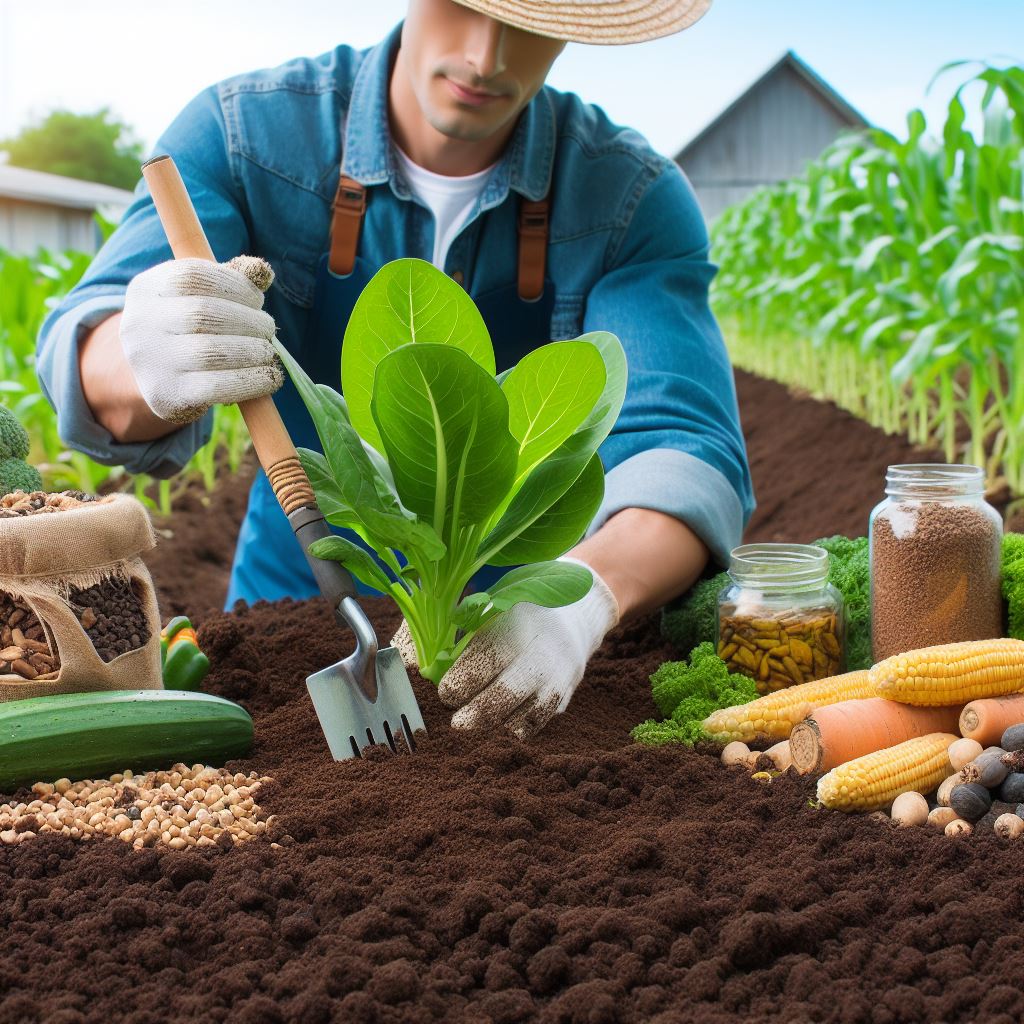Introduction
Microbes are the unsung heroes of healthy soil, silently working their magic to sustain our planet.
This blog section explores the importance of healthy soil and the instrumental role that microbes play in its overall health.
A healthy soil ecosystem is vital for sustainable agriculture and the preservation of ecosystem biodiversity.
The quality of soil directly impacts crop growth, water filtration, and carbon sequestration.
Without healthy soil, our food security and the health of our planet are at risk.
Microbes, such as bacteria, fungi, and archaea, are the invisible workers of the soil ecosystem.
With their microscopic size, they enable essential nutrient cycling, soil structure formation, and disease suppression.
By breaking down organic matter and releasing nutrients, microbes enhance nutrient availability to plants and support their growth.
The role of microbes in soil health cannot be overstated. They engage in symbiotic relationships with plant roots, forming mycorrhizal associations that facilitate nutrient uptake.
Microbes also produce antibiotics and enzymes that help protect plants from harmful pathogens and pests.
Moreover, microbes play a vital role in carbon sequestration.
They capture atmospheric carbon dioxide and store it in the soil, mitigating climate change.
Without them, carbon that would otherwise contribute to greenhouse gas emissions would be released into the atmosphere.
In summary, healthy soil is dependent on microbial magic. These invisible organisms enhance nutrient availability, foster plant growth, and contribute to carbon sequestration.
Recognizing and harnessing the power of microbes is essential for sustaining our planet and ensuring the health and productivity of our soil.
Transform Your Agribusiness
Unlock your farm's potential with expert advice tailored to your needs. Get actionable steps that drive real results.
Get StartedWhat are Soil Microbes?
Definition of soil microbes
Soil microbes are microscopic organisms that live in the soil, including bacteria, fungi, protozoa, and other microorganisms.
Types of soil microbes
There are various types of soil microbes, such as bacteria, fungi, protozoa, nematodes, and arthropods.
Explanation of their functions in the soil ecosystem
Soil microbes play crucial roles in the soil ecosystem. Here are some of their main functions:
Decomposition
Bacteria and fungi decompose organic matter, releasing nutrients that plants can use.
Nutrient cycling
Soil microbes contribute to the cycling of essential nutrients like nitrogen, phosphorus, and carbon.
Improvement of soil structure
Certain microbes produce substances like glues and gums that help bind soil particles together, enhancing soil structure and stability.
Symbiotic relationships
Some soil microbes form mutually beneficial relationships with plants. For example, mycorrhizal fungi assist in nutrient uptake by plants.
Pathogen suppression
Certain soil microbes can inhibit the growth of plant pathogens, protecting plants from diseases.
Detoxification
Soil microbes can break down and detoxify various pollutants and contaminants, contributing to soil health and environmental remediation.
Carbon storage
Soil microbes contribute to carbon sequestration, helping to mitigate climate change by storing carbon in the soil.
Water filtration
Microbes in the soil play a vital role in the filtration and purification of water as it passes through the soil profile.
Overall, soil microbes form a complex web of interactions and functions in the soil ecosystem, influencing soil fertility, plant growth, and overall ecosystem stability.
In recent years, there has been growing interest in understanding the diversity and functions of soil microbes and how they can be harnessed for sustainable agriculture and environmental management.
Researchers are exploring the potential of using specific soil microbes as biofertilizers or biocontrol agents to enhance crop productivity and reduce the need for chemical inputs.
Additionally, promoting practices that support soil microbial communities, such as reducing tillage, diversifying crop rotations, and adding organic amendments, can help maintain healthy soil ecosystems with abundant and resilient microbial populations.
Understanding and harnessing the microbial magic happening beneath our feet can contribute to the development of sustainable and regenerative agricultural systems that prioritize soil health and environmental resilience.
Read: Sustainable Soil: Composting Do’s and Don’ts
The Benefits of Microbial Activity
In healthy soil, microbial activity plays a crucial role in maintaining its fertility and overall health.
Breakdown of organic matter
- Microbes break down dead plants and animals, converting them into nutrient-rich organic matter.
- This process releases essential nutrients back into the soil, making them available for plant uptake.
- It improves soil structure by creating stable aggregates that enhance water infiltration and root penetration.
Nutrient cycling and availability
- Microbes decompose organic matter, releasing nutrients like nitrogen, phosphorus, and potassium into the soil.
- They also convert complex organic compounds into simpler forms that plants can readily absorb.
- This nutrient cycling ensures a continuous supply of essential elements for plant growth.
Disease suppression
- Beneficial soil microbes can suppress disease-causing pathogens through various mechanisms.
- They can directly attack pathogens, compete for resources, or stimulate the plant’s defense mechanisms.
- This natural disease suppression reduces the need for harmful chemical pesticides.
Improving soil structure and water-holding capacity
- Microbial activities, such as the secretion of sticky substances, help glue soil particles together.
- This binding effect creates aggregates that improve soil structure and increase its water-holding capacity.
- Well-structured soil retains moisture, reducing the need for irrigation and preventing water runoff.
In fact, the benefits derived from microbial activity in soil are numerous and vital for sustainable agriculture.
By breaking down organic matter, microbes release essential nutrients and improve soil structure.
They also contribute to disease suppression, reducing the reliance on harmful pesticides.
Furthermore, the microbial nutrient cycling ensures a continuous supply of elements essential for plant growth.
Overall, nurturing the microbial magic in the soil is key to cultivating healthy and productive crops.
Read: Revitalize Your Soil: Organic Matter Secrets
Showcase Your Farming Business
Publish your professional farming services profile on our blog for a one-time fee of $200 and reach a dedicated audience of farmers and agribusiness owners.
Publish Your Profile
Strategies for Boosting Microbial Activity
Boosting microbial activity in the soil is crucial for maintaining soil health and promoting sustainable agriculture.
This section explores various strategies that can be employed to enhance microbial magic in our soil.
Avoiding excessive tilling and soil disturbance
Excessive tilling can have detrimental effects on soil microbial communities.
When soil is repeatedly tilled, it disrupts the natural architecture and compacts the soil, leading to reduced pore spaces.
These pore spaces are crucial for gas exchange, water infiltration, and root growth.
Microbes play a vital role in decomposing organic matter and cycling nutrients in the soil.
However, excessive tilling can destroy their habitats and disrupt their delicate balance.
The exposed soil becomes vulnerable to erosion, nutrient loss, and decreased fertility. It also negatively impacts soil structure and water-holding capacity.
To mitigate these negative effects, farmers and gardeners are increasingly adopting alternative methods such as no-till or reduced-till farming.
These practices minimize soil disturbance, leaving the soil structure intact and preserving microbial communities.
No-till farming involves planting seeds directly into untilled soil, while reduced-till farming uses minimal tilling to prepare the soil for planting.
Using cover crops and crop rotation
Cover crops are an excellent tool for supporting microbial life in the soil. These crops are planted during fallow periods or alongside cash crops as a living cover.
They help prevent erosion, retain moisture, and enhance nutrient cycling.
In addition, cover crops act as a host for beneficial microorganisms, providing them with a habitat and a food source.
As cover crops grow and eventually decompose, they release organic matter into the soil, enriching it with nutrients and supporting microbial growth.
Crop rotation is another effective strategy for maintaining microbial diversity and promoting soil health.
By alternating the types of plants grown in a particular area, farmers can prevent the buildup of specific pests, diseases, and pathogens.
This diversity creates a more balanced ecosystem that benefits soil microorganisms.
Applying organic matter and compost
Organic matter is a key component in feeding soil microbes. It provides a range of nutrients necessary for microbial growth and activity.
Incorporating organic matter into the soil increases its organic carbon content, which serves as an energy source for microorganisms.
Compost, a form of decomposed organic matter, is highly beneficial in boosting microbial activity.
It contains a diverse community of microorganisms that contribute to nutrient cycling and organic matter decomposition.
When added to the soil, compost introduces beneficial microbes, enriches the microbial diversity, and enhances overall soil health.
Applying organic matter and compost to the soil improves its structure, water-holding capacity, and nutrient availability.
It also enhances the microbial population, creating a favorable environment for plant growth and productivity.
In essence, implementing strategies to boost microbial activity in the soil is crucial for maintaining healthy soils and sustainable agriculture.
Avoiding excessive tilling, using cover crops and crop rotation, and applying organic matter and compost are effective methods that support microbial magic in the soil.
By prioritizing soil health, we can ensure the long-term productivity and resilience of our agricultural systems.
Read: Eco-Friendly Soil: Essential Nutrients Guide
Supporting Microbes with Proper Soil Management
In order to support and enhance the growth of beneficial microbes in soil, proper soil management is crucial.
Here are three important strategies to consider:
Maintaining pH balance
- Test the soil pH regularly to ensure it is within the optimal range for microbial activity.
- Adjust the pH if necessary by adding lime to raise pH or sulfur to lower pH.
- Avoid extreme pH levels, as they can negatively affect microbial populations.
Balancing soil moisture and aeration
- Ensure proper drainage in the soil to prevent waterlogged conditions that can harm microbial activity.
- Regularly monitor soil moisture levels and irrigate as needed to maintain optimal moisture for microbial activities.
- Use organic mulches to help retain soil moisture and improve soil structure.
Avoiding overuse of chemical fertilizers and pesticides
- Reduce reliance on synthetic fertilizers by incorporating organic matter, such as compost, which provides essential nutrients for both plants and microbes.
- Implement integrated pest management practices to minimize chemical pesticide use and encourage natural pest control.
- Choose organic or bio-friendly alternatives when pesticides are required, as they are less harmful to soil microbes.
Overall, proper soil management is essential to create a favorable environment for beneficial microbes.
By maintaining pH balance, balancing soil moisture and aeration, and minimizing chemical inputs, microbial populations can thrive, influencing soil health and plant productivity.
Read: Maximize Fertility: Smart Crop Rotation Methods
Conclusion
Soil microbes play a vital role in maintaining healthy soil. These microscopic organisms break down organic matter, release nutrients, and improve soil structure.
Implementing soil strategies that enhance microbial activity is crucial for sustainable agriculture.
Farmers and gardeners should prioritize practices such as cover cropping, crop rotation, and reducing tillage to promote a diverse microbial community.
By doing so, they can improve nutrient availability, reduce soil erosion, and increase crop yields.
It is important to understand that healthy soil is the foundation for strong and resilient plants.
By harnessing the power of soil microbes, we can create a thriving ecosystem that supports both our food production and the environment.
Showcase Your Farming Business
Publish your professional farming services profile on our blog for a one-time fee of $200 and reach a dedicated audience of farmers and agribusiness owners.
Publish Your ProfileSo, let’s take action today and adopt these soil strategies in our farming and gardening practices.
Together, we can foster microbial magic in our soils and create a sustainable future for generations to come.




